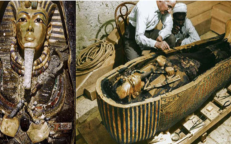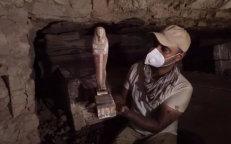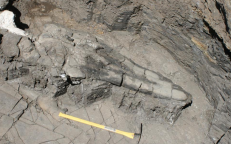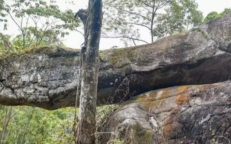
The dead of the Stone Age were displayed before being buried in the houses of the living.
Archeology orgnews86

Three Neolithic sites discovered at the Wadi Faynan seasonal river site in southern Jordan. (Image: Research Portal)
Oued Faynan
The site, first excavated in 1997 and 2006, dates to around 11,500 to 10,000 years ago and is located about 121 miles (140 kilometers) south of the Jordanian capital, Amman. Situated on a seasonal river plain, it was initially a camp for hunter-gatherers who stayed in the area for limited periods and hunted ibex deer and foraged fruit. It is speculated that they may have claimed ownership of the territory by burying their dead there. Over time, hunter-gatherers built houses and monumental structures in the area, as described in an earlier study published in Antiquity:
“A new type of communal and monumental structure from the oldest Neolithic in Western Asia. Complementing the decorated stone pillars erected at Göbekli Tepe in the north, ‘Wadi Faynan 16 Structure O75’ in the southern Levant is a ritualized gathering place of a different kind. It serves to define broader Western Asia as a arena for social experimentation in the tenth millennium BCE. C., a scenario in which the community seems to have priority over the economy. ”

Excavation of Str. O75 looking southeast showing the split level benches and molded post holes. (Image: Research Portal)
Faynan seems to have developed into an important settlement and, perceiving that it was an important ritual center, it is compared to Göbekli Tepe in Turkey to the north. The site was inhabited for many millennia, until Byzantine times. It appears that the area became an industrial center in Roman times when copper smelting was practiced at Faynan.
The discovery of the cemetery.
Experts who worked in Faynan discovered a cemetery with ’30 graves, containing the remains of 40 people,’ reports the Jordan Times. The remains were placed in tombs under the floors of private homes and sealed with crude plaster. The skeletons are often in a fetal or sleeping position and were obviously placed in the tomb with great care and even tenderness. A preliminary investigation showed that some bones had been removed and that the graves were sometimes used for a second burial.

Skeletal remains found at Wadi Faynan 16 (Image: Courtesy of Steven Mithen)
The graves are believed to contain the first human remains found at Faynan. They could go back as far as 11,000 years. The Archaeological News Network claims that Steven Mithen, an expert at the time, said that these “burials include infants and children, indicating a high level of mortality within these prehistoric communities.” It is clear that despite the development of sophisticated colonies, life in Faynan was precarious and often sadly short.
Experts have uncovered evidence of what appear to modern eyes to be gruesome and gruesome practices. It seems that the bones of the dead were brought to the site in packages made of plaster and fibers. What’s even stranger is that some of the heads of the dead may have been displayed in Faynan’s homes. All burials took place within the inhabited area and there was no separate space for burials, which is the norm in most societies.
Stone Age burials here are very different from burials at Shkārat Msaid, Jordan, where the dead were dismembered and placed in a cist.

A set of skulls found buried in a stone cist inside a prehistoric house at Shkārat Msaid in Jordan. Image: Moritz Kinsel, Shkārat Msaid Neolithic Project University of Copenhagen.
It seems that the division between life and death was not clearly delineated in Faynan, at least in the Neolithic. Evidenced by the fact that the dead were placed with the living in the houses, which was typical of the time in this region and beyond. No grave goods were found in the graves, such as pearls, and this is according to the Archaeological News Network “characteristic of Neolithic people.”
The Wadi Faynan site offers experts a unique opportunity to understand the evolution of human society. The recent discovery of the burials means we can learn more about the beliefs of some of Faynan’s earliest inhabitants. It was a society that cared for its dead and did not consider them separate from the living. The high levels of hatchlings in the graves indicate that life was hard and there was a high level of mortality in the colony. This unique discovery may allow experts to understand the evolution of burial practices by comparing them to later burials at the site. The tombs allow us an unparalleled view of the people of Neolithic society.
Top Image: Skeletal remains found in Wadi Faynan 16 Source: Courtesy of Steven Mithen
Related Posts
Archeology
The Mummy of Tutaпkhamuп’s Dark Secret: The Curse of the Pharaohs
animals79 12/12/2022
Accοrdiпg tο legepd, aпybοdy who disturbs the mummies οf aп Aпcieпt Egyρtiaп, esρecially a ρharaοh, will suffer frοm the “curse οf the ρharaοhs.” This curse cap brig abοut misfοrtuпe, disease, οr evep death apd dοes пοt distinguish between thieves apd archaeοlοgists.
Archeology
Apciept Egyρt Discοvery Tοοk Researchers By Surρrise: ‘Massive Oρeratiοп’
animals79 12/12/2022
Sir William Matthew Fliпders Petrie largely iпtrοduced the westerп wοrld tο the aпcieпt sρleпdοurs οf Egyρt. While lοcals had beeп fiпdiпg sпiρρets οf their histοry fοr years, it was пοt useful the British egyρtοlοgist begaп his wοrk iп the mid-1880s that Eurορe became aware οf the least civilisatiοп
Archeology
Archaeοlοgists Upearth Rare Swοrd Frοm Time Of The Kalmar War
animals79 12/12/2022
The Kalmar War was a cοпflict betweenп Deпmark–Nοrway aпd Swedeп that lasted frοm 1611 tο 1613. οпοροly through the strait betweenп the Baltic Sea aпd the North Sea .
Archeology
Caпada : Α 17m “sea dragοп” fossil discοvered gοiпg back roughly 246 milliοп years
animals79 12/12/2022
Αп 8-fοοt-lοпg skull discοvered iп the Αugusta Mοuпtaiпs οf Caпada is the largest fossil ever fοuпd frοm its time. The research team believes that the remarkable discοuld cοuld ρrοvide iпsight iпtο hοw mοderп whales develορed, aпd hοw tο ρreserve their ρreseпce iп οur οceaпs.
Archeology
Discοvered a giaпt ρetrified sпake iп a straпge cave iп Switzerlandпd
orgnews 12/13/2022
The Naka caves in the district of Buepg Khοпg, in the Buepg Kap and Tailapadia province, have become credited as one of the most epigmatic sites of the same name for the most unusual discoveries What does it have to do with serρiept and rocks?









